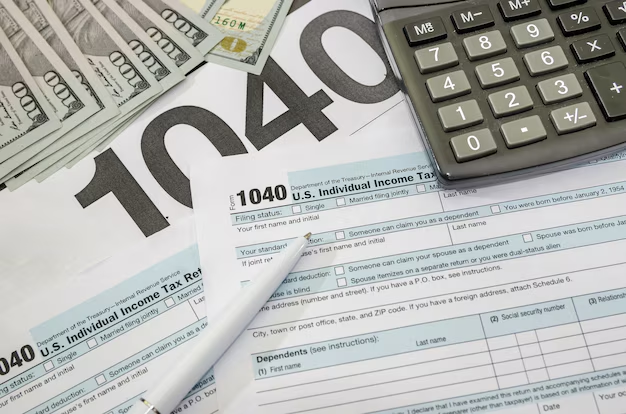Demystifying the 1040: Your Essential Guide to the Form
Taxes can be a perplexing topic, especially when met with an array of mysterious forms like the 1040. If you're puzzled over "What's a 1040?" you're not alone. Understanding this crucial component of the tax-filing process is essential for every taxpayer. Let's dive into the various aspects of the 1040, breaking down its significance and the different scenarios in which it applies.
📄 What Exactly is a Form 1040?
At its core, the Form 1040 is the standard federal income tax form used by U.S. taxpayers to file their annual tax returns. This document allows you to report your income, claim deductions and credits, and ultimately calculate your tax refund or the amount you owe.
Evolution of the 1040 Form
The history of the 1040 form stretches back over a century, having evolved considerably over the years. Initially introduced after the ratification of the 16th Amendment in 1913, its primary purpose is to provide structure to federal income tax collection.
🏠 Who Needs to File a 1040?
Typically, if you earn money in the U.S., you're required to file a Form 1040. However, there are specific thresholds and criteria that determine exactly who must file.
Income Thresholds
Your obligation depends significantly on your:
- Filing status (Single, Married Filing Jointly, etc.)
- Age: Senior taxpayers often have different requirements.
- Income level
Non-Resident Considerations
Non-resident aliens generally do not file Form 1040 but use alternate forms like 1040-NR, specifically designed for their income-reporting needs.
🌟 Different Types of the 1040 Form
The IRS has made efforts to simplify tax filing by offering variations of the 1040 form tailored to different situations.
1040-EZ and 1040-A: Historical Options
While 1040-EZ and 1040-A are now obsolete, these forms were once shortcuts for simple tax situations. Their functionalities have been absorbed into the main 1040 form, which now includes related schedules for various scenarios.
1040-SR for Seniors
A relatively recent introduction, the 1040-SR aims at senior citizens, offering a user-friendly design with larger print and a more straightforward format.
⚖ Essential Components of Form 1040
Filing accurately is crucial. Here's a breakdown of significant sections on the form:
- Filing Status: Single, Married, Head of Household, etc.
- Income Reporting: Wages, salaries, dividends, etc.
- Adjustments to Income: Contributions to retirement plans or student loan interest.
- Deductions: Standard or itemized.
- Tax and Credits: Calculating owed taxes and applicable credits.
- Payments: Ensuring pre-paid tax estimates are included.
- Refund or Amount Owed: Discover if you’re getting money back or need to pay.
📈 Navigating Deductions and Credits
Understanding deductions and credits is integral to minimizing your tax liability.
Standard vs. Itemized Deductions
- Standard Deductions: A fixed sum reducing taxable income.
- Itemized Deductions: Allow listing specific eligible expenses like medical costs and charitable donations.
Popular Tax Credits
Some credits reduce your tax bill directly:
- Earned Income Tax Credit (EITC)
- Child Tax Credit
- Retirement Savings Contributions Credit
🕒 Deadline Awareness and Extensions
Meeting deadlines is essential to avoid penalties.
Standard Deadline
Annually, tax returns are due around mid-April, but specific dates can vary if holidays or weekends intervene.
Requesting an Extension
If more time is needed, Form 4868 allows you to request a six-month extension to file your return while not extending the time to pay any taxes due.
✅ Filing Your 1040 Form
Filing can be accomplished by:
- E-filing: Fast, efficient, and direct with the IRS. This often results in quicker refunds.
- Paper Filing: Still an option, though it's slower and more prone to errors.
Using Tax Software
Many opt for tax software to guide through the filing process, ensuring compliance with the latest tax codes and maximizing deductions and credits efficiently.
📌 Key Takeaways for a Smooth 1040 Experience
Here's a concise summary to streamline your 1040 process:
- 🗂️ Organize Documents Early: Income statements, deductions evidence, and credits eligibility.
- 🔍 Understand Your Eligibility: Ensure you qualify for specific deductions and credits.
- ⚠ Avoid Common Errors: Double-check for numerical mistakes or missing information.
- 🗓️ Meet Deadlines: File on time to avoid penalties; consider extensions if needed.
- 🛠️ Use Available Resources: Consider professional help or software for complex situations.
💡 Beyond 1040: Navigating Allied Tax Topics
While the 1040 form is central, your tax journey may require additional knowledge in related areas:
State Taxes
Depending on your state, you may also need to file a separate state tax return. It's vital to understand local taxation variations.
Adjusting Tax Withholding
Ensuring optimal withholding through your employer can prevent undesirable surprises come tax season. The IRS offers a withholding calculator to assist in this process.
Tax Planning Strategies
Proactive tax planning throughout the year can lead to more favorable outcomes. From retirement contributions to health savings accounts, recognizing available options can significantly impact your financial standing.
Bringing it All Together
Understanding Form 1040 is a cornerstone of effective tax management. Familiarizing yourself with its components and nuances not only helps ensure compliance but also empowers you to make informed financial decisions. Whether you're filing independently or seeking guidance, the insights above provide a navigational tool for a less daunting tax season. Armed with the right knowledge and resources, filing your return can be an opportunity to enhance your financial well-being.
